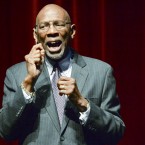We Can’t Wait for Superman
Dr. Geoffrey Canada told this story the other morning in Longview, to a crowd gathered in the Belcher Center on the LeTourneau University campus for the Poverty Conference, sponsored by the Junior League. An acclaimed documentary called “Waiting for Superman” was produced a few years back, in part featuring his work creating the Harlem Children’s Zone. Canada was raised in the South Bronx of New York City, a tough neighborhood. His work with his team cleaning up and taking back 97 blocks of Harlem and serving thousands of kids over the past 30 years is the crux of his story.
Canada said when he was young, maybe fourth grade, he loved reading Superman comic books. It provided a respite from the violence, poverty and danger of the South Bronx. But one day, his mother told him Superman was not real. He was crushed, not in the way children react when told Santa Claus is also a fiction. Canada was crushed because if there was no Superman, then there was no one who could come in and save him from the depths of the ghetto. “There was no one coming with the power to save us.”
A tall, thin man who is now 63, Canada paced the stage restlessly with long strides, his hands accompanying the torrent of words spoken eloquently and without notes. His passion is contagious, his humor infectious. Normally he does not make overnight trips so that he can be with his family by nightfall. He made a rare exception for the Poverty Conference. As he traveled from his hotel to the Belcher Thursday morning, he noticed what those of us who work on the south side of Longview see every day: homes with bars on the windows, unkempt vacant lots littered with trash, a child waiting for the bus.
“That little boy headed to school this morning looked a little scared, a little lost. That was me,” he said. The problems we face in Longview are no different than anywhere else, he said. “I have yet to be anywhere there isn’t a problem.”
In Harlem, after receiving a doctorate from Harvard, Canada put together a team, raised money and set out to rebuild a borough sagging from years of neglect, decay and violence — block by block. It was not easy, but 15 years later they had transformed Harlem. “It is now a place people are dying to get to, not get out.”
They knocked on doors and asked skeptical residents, “We want to organize this block and clean it up. Will you help us?” And slowly, they did.
“You think when you go in to help people, they are going to love you. They are not!” Canada said to widespread laughter. “They are suspicious.”
The situation in Harlem, in Longview and in cities large and small has become more dangerous than when Harlem was young. Then, disputes were solved with fisticuffs, not Glocks. When fights occurred when he was a kid, “they weren’t lethal. Now they go home, get a gun and shoot the other kid.”
In Harlem, where his work started in 1983, by 1989 he had lost 11 kids to violence. But today, nearly 1,000 students from Harlem are in college. Graffiti is gone. Nearly 14,000 youth are served by the Harlem Children’s Zone, as well as their parents. Canada retired last year, but the work continues, and he has more time to spread his message: “Education is the only way to break the cycle of poverty.”
To widespread applause he said something considered controversial by some. “If you’re a teacher, and you cannot teach, you probably should get another job.”
If you went to a hairdresser who butchered your hair, would you go back? he asked. Of course not. But too many school districts retain teachers who are inept. In the South Bronx, for example, Canada said nothing has really changed since he was a child in the early 1960s.
“Millions of children have been ruined there,” he said angrily.
The costs are so high it boggles the mind. The price tag to keep someone in jail in New York City is $167,000 a year. The Harlem Children’s Zone spends $5,000 per child in its program. The national cost for incarceration is much lower, about $42,000, but still many times more than what is spent per child on education. The United States has one of the highest incarceration rates in the world. We spend an incredible amount of money putting people behind bars.
So who is going to “fix” this problem? Canada said he has talked with presidents, secretaries of education and other high-ranking officials for decades. The bad news: “There is no plan. We have to do it ourselves.”
His final charge to the audience of about 500 was this.
- Don’t be like the skeptics who think you can’t do this. None of these problems are unique to a community.
- If young people lose a sense of optimism, they are doomed, and they need faith to get through the hard times. “You have to have it before you need it.”
It is possible to change a community, block by block, child by child. As Canada put it, “Despair is infectious, but so is hope.”
If it can be done in Harlem, it can be done here.
Postscript: I work for Thrive360,a local nonprofit that was a co-sponsor of the Poverty Conference. Check us out at thrive360.net.)
Leave a reply
Fields marked with * are required












